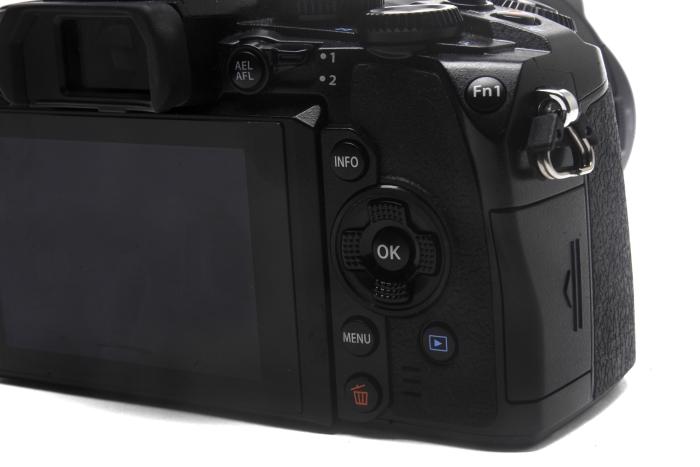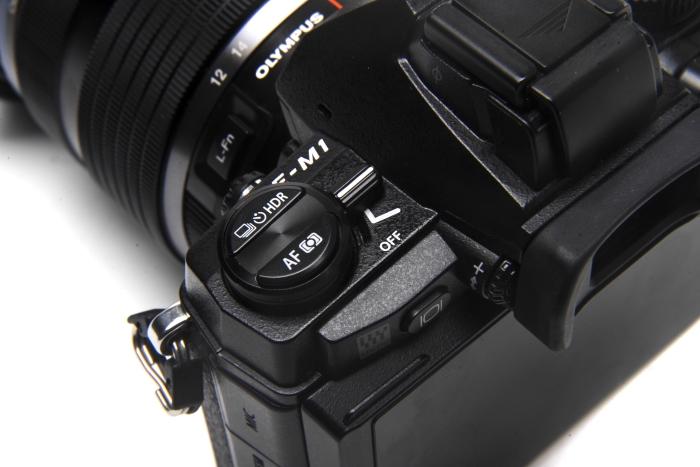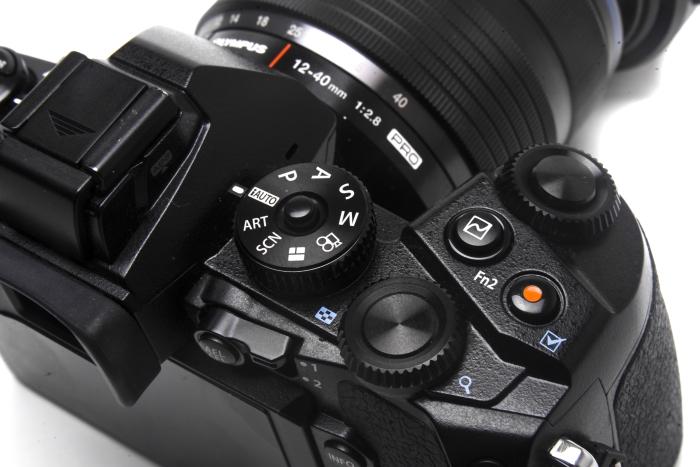
Olympus OM-D E-M1 camera
The flagship OM-D E-M1 is packed with features, is intuitive, and supplies excellent image quality
Pros
- Strong build quality
- Excellent controls
- Excellent image quality
- Fast performance
Cons
- Shutter button too squishy for our liking
- Some noticeable LCD and EVF flickering under fluro lights
Bottom Line
The OM-D E-M1 takes over as the flagship camera for Olympus. It's a Micro Four Thirds-based camera with a stack of features that's aimed at those of you who want more of a 'pro' feel from a compact system camera. We love it.
-
Price
$ 2,399.00 (AUD)
The OM-D E-M1 represents the best that Olympus has to offer in the compact system camera (CSC) market. It's a Micro Four Thirds-based, interchangeable lens camera that balances the needs of pros and enthusiast photographers in one neat, and solid package. There are tons of features to explore, which can make the shooting experience a more enjoyable one, and intertwined among all the advanced manual controls are numerous scene modes and art filters that are customary in today's camera market.
Note: Sample images are at the end of the review.
The feel of the OM-D E-M1 provides a first impression that's as positive as impressions get for a camera. It has a sturdy body with a comfortable handgrip and a dedicated resting place for your thumb, and it has the feel of a valuable tool rather than a toy. There is a heft to the body that's reassuring, and its magnesium alloy frame is sealed so that it can withstand adverse weather conditions. Olympus even sells some sealed lenses (such as the M.Zuiko Digital 12-50mm f3.5-6.3), which, when attached to the E-M1 body, basically form a complete weatherproof camera that can keep splashes of water from penetrating the perimeter.
You don't get a built in flash with this model (there are optional flashes that fit in the hot-shoe, and the camera can use external flashes, too), but you do get an integrated electronic viewfinder (EVF), and to our eyes it's one of the best in the business. It becomes a crucial part of the overall usefulness of this camera because you can use it in the brightest of environments to see exactly how your shots will turn out. You can see the whole seen that you are about to capture, and all of the settings are displayed right there on the EVF's screen. The only thing about the EVF that we found annoying was noticeable flickering when using it indoors in an office with fluorescent light tubes (it was more visible through the EVF than on the LCD screen).
During times when you don't want to use the EVF, you can frame your shots through the 3in LCD display, which has a crisp quality. It resides on a hinge that allows it to tilt, which can be very useful when you want to take shots from the hip, or from above your head. Despite being hinged, the screen doesn't make the camera feel bulky. It's also a touchscreen, which allows you to flip through photos easily during playback, and also to focus and take photos with a simple tap.
Importantly, what you see through both the EVF and the LCD screen is what you get, and this is what makes shooting with the E-M1 (and other Olympus cameras for that matter) so much fun. You don't have to take a photo multiple times to get it right, because any changes you make to the exposure will show up immediately in the live view.
Extensive controls
An array of controls and buttons line almost all of the major surfaces of the camera's body, and they are there to be learned and taken advantage of. If you want a camera to plonk in auto mode and let it do all the work, you'll be better off with a simple compact — or at least a cheaper CSC, such as the Olympus PEN E-P5. This camera is like a multi-tool for any photographic job that you can imagine (as long as you have the right lens). That's not to say that it can't be used in automatic modes, but you'll get the most enjoyment out of it if you make use of all its features and take command of the exposure settings.
The layout of the dials means you can easily change aperture and shutter while still looking through the viewfinder, and there is a feature that can give you even more exposure settings at your fingertips: it's called the 2x2 control. The 2x2 control is a switch just to the right of the EVF, and it has two positions. Left in the up position, the switch allows the index finger and thumb controls to manipulate the aperture and shutter. The down position changes the functions so that you can use the controls to manually adjust the white balance and the aperture.

In addition, there are two buttons to the left of the viewfinder. By default, these can change the drive and focus features of the camera. With a flick of the 2x2 switch, they can be used to change flash settings and enable bracketing. All up, the new 2x2 control allows you to have eight controls for exposure, drive and focus, within quick reach. It's a very convenient feature and one that's new to the OM-D range.

There are two customisable function buttons on the camera, both within easy reach of your right index finger and thumb. The one that can be controlled with your index finger is assigned to perform highlights changes by default. When pressed, a highlights and shadows curve appears on the screen and you can use the index finger and thumb control dials to change the look of dark and bright areas in your photos. All of this can be done in real-time and you can see the changes taking place immediately as you move the curve. However, the changes can sometimes be hard to see because they are so subtle, which can cause you to play with the curve a little too much (well, we did, at least).

At this point we should mention that all of the dials and switches have a soft, yet responsive feel to them. The mode dial at the top of the camera has a lock on it in the form of a button. When you press it, the dial can't move. We like this better than the locks on some digital SLRs that we've seen, which sometimes require you to hold down a lever while moving the dial. Our only qualm about the way the camera feels is the squishy shutter button. While its two steps for focusing and taking a shot are easily distinguished, we nevertheless wish it had more of a crisp feel.
Despite all of the buttons and features, it's an intuitive camera for the most part, and you can learn it as you go by just perusing the menu and trying new things. You might not even have to consult the manual.
Performance
On the inside, the E-M1 features multi-core processing, a 16-megapixel Live MOS sensor, and Olympus has removed the low-pass filter (which is said to improve sharpness). The processing power, in conjunction with a fast SD card, provides excellent shot-to-shot performance, and very fast frame capture in burst mode. We managed to record up to 104 frames in a burst period of 10sec using a 64GB SanDisk Extreme Pro SD card, at which point the camera slowed down a little bit, but still kept a swift pace (this was in JPEG mode). Basically, we found it to be a fast camera when used with the SanDisk Extreme Pro, making it perfect for action photography.
The powerful processor is needed not only for the recording speed, but also to handle moiré patterning from the removal of the low-pass filter, and to crunch the data from live imaging features that have been introduced with this model. One of these is the highlights adjustment feature, which we mentioned earlier and which allows you to change the shadows and highlights in a scene in real-time as you're taking the shot. Another of these features is the manual focus assist, which highlights different areas of an image as you move the focus ring, making it easier to see which part of the image is in focus. In-camera HDR processing is also present, hue and saturation can be changed in real-time, and art filter processing is done at a faster clip than before when using video mode.
We found the focusing performance of the camera to be good overall. Autofocus actions were conducted as quickly as we've seen from a Micro Four Thirds camera, and the ability to change focal spots was as easy as using the directional buttons on the back of the camera or tapping on the desired spot on the screen. The lens changed effortlessly from foreground to background focal planes when we tapped on the screen, making it easy to get different looks, especially when shooting things such as flowers. Manual focus was a joy to use thanks to the clarity of the screen and the EVF, and the assist feature that highlights the plane that's in focus came in very handy.
The lens we used for our tests was the M.Zuiko 12-40mm 1:2.8, which has a maximum wide aperture of f/2.8 throughout its zoom range. It's part of the Pro kit for this camera (though you can also buy a Weatherproof kit or the body only), and it performed well for us in our evaluation of this camera. Primarily, we had fun blurring out the background when shooting flowers and other objects at close range using the f/2.8 aperture, with some nice patterns forming around our subject. It's important to note that you can use the wide aperture even in bright conditions because the shutter speed can be taken all the way up to 1/8000th of a second.
Images were as crisp as we expected them to be when we scrutinised them at their native size, and even the use of a high ISO speed didn't cause problems. Indeed, for low-light shooting, we found this camera and lens combination to be excellent. Colours were rendered richly, though you can select the style and intensity of the colours through the menu when shooting in JPEG mode. You can also shoot RAW. Have a look at the sample images below to see what this camera can do. We're not great photographers, but they should give you a good idea of the results you can expect to achieve.
Conclusion
The OM-D E-M1 is perfect if you want a camera that will allow you to very easily take complete control over exposure settings. It has a great array of controls and intuitive new features that we found to be useful. Coupled with 5-axis image stabilisation that's built in to the body, and standard features we're used to seeing on Olympus' compact system cameras, such as scene and art modes, it makes for a wonderfully rounded camera that can be used in just about any situation. It even has a Wi-Fi mode that works very well for transferring photos (and remote control) in conjunction with the Olympus O.I Share app for iOS and Android. Basically, if you're in the market for a high-end compact system camera, it's hard to pass on the OM-D E-M1 and its ecosystem of lenses and accessories.
Pricing
| Kit configuration | Australian price | New Zealand price |
| E-M1 Body only | $1599 | $1899 |
| E-M1 Weatherproof kit (12-50mm) | $1899 | $2999 |
| E-M1 Pro Kit (12-40mm) | $2399 | $2899 |
Sample images















Brand Post

Most Popular Reviews
- 1 Dell U3223QE review: A winning debut for an IPS Black monitor
- 2 HP Spectre x360 16 review: The right 2-in-1 at the wrong time
- 3 Acer K242HYL review: An affordable monitor for any occasion
- 4 GeForce Now review: You bring the games, Nvidia streams the hardware
- 5 Asus ProArt PA279CV monitor review: The go-to for content creators on a budget
Latest News Articles
- Apple offers 6 months free Apple Music, Keynote holiday greeting card templates
- Adobe expands Creative Cloud M1 support, claims over 80% better performance than Intel
- GoPro delivers Quik solution for videos and photos
- Got a GoPro Hero 8? You can use it as a webcam for your Mac
- Canon embolden mirrorless offering with EOS R5 and R6
Resources
Macworld
What's new, plus best mac-related tips
and tricks

Business Centre
The latest business news, reviews, features and whitepapers

Videos
Watch our video news and reviews from around the world

Guides
Comprehensive buying guides, features, and step-by-step articles

PCW Evaluation Team
Pedro Peixoto
Aruba Instant On AP11D

Set up is effortless.
Cate Bacon
Aruba Instant On AP11D

The strength of the Aruba Instant On AP11D is that the design and feature set support the modern, flexible, and mobile way of working.
Dr Prabigya Shiwakoti
Aruba Instant On AP11D

Aruba backs the AP11D up with a two-year warranty and 24/7 phone support.
Tom Pope
Dynabook Portégé X30L-G

Ultimately this laptop has achieved everything I would hope for in a laptop for work, while fitting that into a form factor and weight that is remarkable.
Tom Sellers
MSI P65

This smart laptop was enjoyable to use and great to work on – creating content was super simple.
Lolita Wang
MSI GT76

It really doesn’t get more “gaming laptop” than this.
Featured Content
- Which Lenovo Laptop Should I Buy?
- Every TV in Samsung's 2022 line-up: OLED, Neo QLED and more!
- Top 10 best Android and Apple phones for under $600
- Everything you need to know about Smart TVs
- What's the difference between an Intel Core i3, i5 and i7?
- Laser vs. inkjet printers: which is better?










